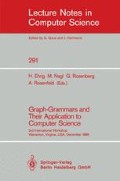Abstract
This paper sketches the approaches of a certain branch of graph grammars mainly studied at Erlangen, Osnabrück, Koblenz and Aachen, West Germany. It is named set theoretic, or expression, or algorithmic approach of graph grammars, because its mathematical base is elementary set theory, expressions are used to denote embedding transformations, and the question of applicability and implementation always was regarded of equal importance as theoretical results.
The paper gives an introduction to this branch of graph grammars by introducing one representative, sketches the theoretical results, the different modifications introduced for applications, and the various fields of applications already studied. It concludes with an outline how graph grammars can be used for conceptual modelling. In all these applications graph grammar modelling is on an abstract level giving, however, deep insight to the solutions for a realization.
Preview
Unable to display preview. Download preview PDF.
Literature
Abe, N./Mitsumoto, M./Toyoda, J. I./Tanaka, J.: Web Grammars and Several Graphs, Journ. Comp. Syst. Sci. 7, 37–65.
Brayer, J.M./Fu, K.S.: Some Properties of Web Grammars, Techn. Rep. TR-EE 74-19, Purdue University.
Bunke H.: Sequential and Parallel Programmed Graph Grammars (in German), Dissertation, University of Erlangen.
Bunke, H.: 1983 Graph Grammars as a Generative Tool in Image Processing, in /ENR 83/, 8–19
Culik, K. II/Lindenmayer, A.: 1974 Parallel Rewriting on Graphs and Multidimensional Development, Technical Report CS-74-22, University of Waterloo, Canada.
Ehrig, H./Claus, V./Rozenberg, G. (Eds.): 1979 Proc. 1st Int. Workshop on Graph Grammars and Their Application to Computer Science and Biology, Lect. Notes in Comp. Sci. 73, Berlin: Springer Verlag.
Ehrig, H.: Tutorial on Algebraic Graph Grammars, this volume.
Ehrig, H./Nagl, M./Rozenberg, G. (Eds.): 1983 Proc. 2nd Int. Workshop on Graph Grammars and Their Application to Computer Science, Lect. Notes in Comp. Sci. 153, Berlin: Springer-Verlag.
Engels, G./Lewerentz, C./Schäfer, W.: Graph Grammar Engineering: A Software Development Method, this volume.
Franck, R.: 1978 A Class of Linearly Parsable Graph Grammars, Acta Informatica 10, 175–201.
Göttler, H.: Graph Grammars in Software Engineering (in German), 275 pp., University of Erlangen.
Kaul, M.: Syntax-Analysis of Graphs Using Precedence Graph Grammars (in German), Dissertation, University of Osnabrück.
Montanari, U.: 1970 Separable Graphs, Planar Graphs and Web Grammars, Inf. Contr. 16, 243–267.
Mylopoulos, J.: On The Relation of Grapf Grammars and Graph Automata, Proc. 11th SWAT Conf., 108–120.
Nagl, M.: 1976 Formal Languages of Labelled Graphs, Computing 16, 113–137.
Nagl, M.: 1979a Graph Grammars: Theory, Applications, Implementation (in German), Braunschweig: Vieweg-Verlag, 375 pp.
Nagl, M.: 1979b A Tutorial and Bibliographical Survey on Graph Grammars in /ECR 79/, 70–107.
Nagl, M.: 1979 Bibliographies on Graph Grammars in /ECR 79/, 108–126 and /ENR 83/ 415–448.
Pfaltz, J./Rosenfeld, A.: Web Grammars, Proc. Int. Joint Conf Art. Int., Washington, 609–619.
Rosenfeld, A./Milgram, D.: 1972 Web Automata and Web Grammars, Mach. Int. 7, 307–324.
Rozenberg, G.: Tutorial on NLC-Graph Grammars, this volume.
Schneider, H.J.: Chomsky-Systems for Partial Orderings (in German), Technical Report IMMD-3-3, University of Erlangen.
Schneider, H.J.: 1976 Conceptual Database Description Using Graph Grammars, in H. Noltemeier (Ed.): Applied Computer Science 4, 77–98, Munich: Hanser-Verlag.
Schütte, A.: Specification and Generation of Translations for Graph Languages by Attributed Graph Grammars (in German), Dissertation, EWH Koblenz.
Uesu, T.: A system of Graph Grammars which generates all recursively enumerable sets of labelled graphs, Tsukaba J. of Mathematics 2, 11–26.
Workshops on Graphtheoretic Concepts in Computer Science held annually since 1972 in Middle-Europe, Proc. appeared by Hanser-Verlag, LNCS of Springer-Verlag, and by Trauner-Verlag, Linz/Austria.
Author information
Authors and Affiliations
Editor information
Rights and permissions
Copyright information
© 1987 Springer-Verlag Berlin Heidelberg
About this paper
Cite this paper
Nagl, M. (1987). Set theoretic approaches to graph grammars. In: Ehrig, H., Nagl, M., Rozenberg, G., Rosenfeld, A. (eds) Graph-Grammars and Their Application to Computer Science. Graph Grammars 1986. Lecture Notes in Computer Science, vol 291. Springer, Berlin, Heidelberg. https://doi.org/10.1007/3-540-18771-5_43
Download citation
DOI: https://doi.org/10.1007/3-540-18771-5_43
Published:
Publisher Name: Springer, Berlin, Heidelberg
Print ISBN: 978-3-540-18771-4
Online ISBN: 978-3-540-48178-2
eBook Packages: Springer Book Archive

